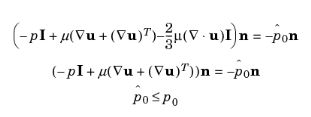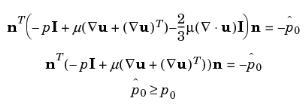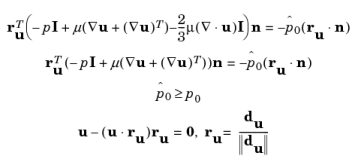This is a normal stress condition together with a no-tangential-stress condition. When μ > 0, Equation 13-15 or Equation 13-16 can be supplemented with a tangential velocity condition
If so, the no-tangential-stress condition is overridden. An issue with Equation 13-15 or Equation 13-16 is that it does not strongly enforce unidirectional flow on the boundary. If the prescribed pressure on an outlet is too high, parts of the outlet can actually have inflow. This is not as much of an issue for the Navier-Stokes equations as it is an issue for scalar transport equations solved along with the Navier-Stokes equations. Hence, when applying the Pressure boundary condition at an outlet or inlet you can further constrain the flow. With the Suppress backflow option
(13-18) ,
,
 ,
,Equation 13-18 effectively means that the prescribed pressure is p0 if u⋅n ≥ 0, but smaller at locations where u⋅n < 0. This means that Equation 13-18 does not completely prevent backflow, but the backflow is substantially reduced.
together with the tangential condition in Equation 13-17, or, a general flow direction is prescribed.
See Inlet, Outlet, Open Boundary, and No Viscous Stress for the individual node settings. Note that some modules have additional theory sections describing options available with that module.

